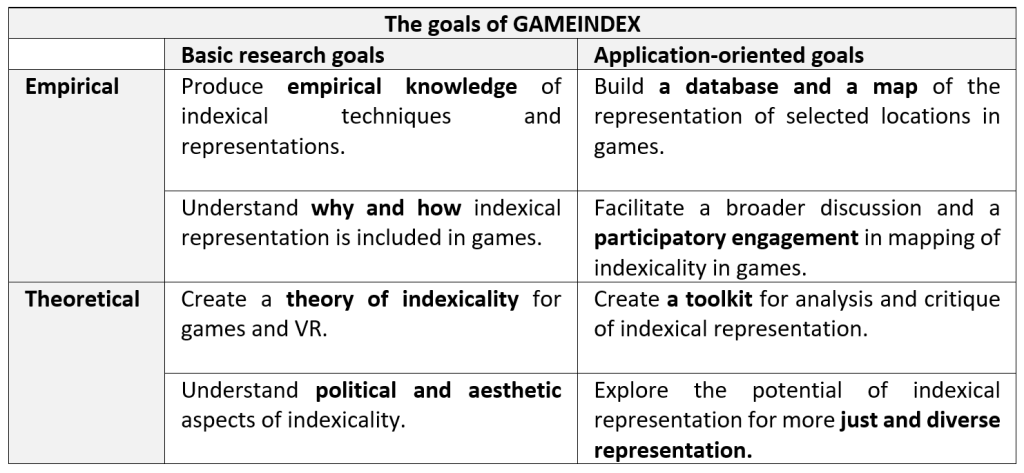GAMEINDEX
The ERC Consolidator project GAMEINDEX: Politics and aesthetics of indexical representation in digital games and VR (2025-2030) focuses on indexical representation in games – both as traces of real-life objects or people in the simulated worlds of digital games and VR, and as references to physical locations. Besides games themselves, we are interested in analyzing indexical techniques such as motion capture, 3D scanning, voiceover recording, and others.
Main objectives
So far, studies of representation in games have focused almost exclusively on the analysis of tropes and stereotypes related to general demographic categories such as gender, race, ethnicity, or age (Williams et al. 2009; Burgess et al. 2011; Malkowski and Russworm 2017). Tropes and stereotypes are symbolic rather than indexical because they are based on established conventions – conventional ways of representing a specific social phenomenon or a social group. In the research of games as well as other media, such research employs methods such as close reading (Bizzocchi and Tanenbaum 2011) or content analysis (Williams et al. 2009; Valeriano and Habel 2016) that primarily center on the representational content of games. Recently, materialist media theory has pointed out the limitations of this approach, and suggested to consider representation “a material practice with material effects.” (Bollmer 2019a, 39; see also Flusser 2011). A similar direction has been suggested by Winston (1985), who showed that the chemical properties of early colour film stock were designed to best reproduce the skin tones of white people – meaning that the material and technical aspects of the medium must be taken into account when studying ideologies in the media.
GAMEINDEX will shift the focus of representation studies from the symbolic and the iconic to the indexical, which necessarily entails a relationship between an individual real-world object or person and its trace or pointer. This approach can provide a much-needed breakthrough in the study of representation in digital games (and other digital media) by enriching the examination of artifacts with an analysis and critique of the production processes. An approach that combines artifact-oriented and production-oriented research will allow us to ask new questions and trace more complex relationships, for example between the lack of representation of diverse body types and both the availability of stock 3D models and the choices made during the casting of motion capture performers – or between the lack of many peripheral locations in digital games and the costs and complexity of 3D scanning and photogrammetry.

GAMEINDEX will be the first project to systematically study indexicality in digital games and virtual spaces. The project will entail a range of empirical studies of indexical production practices and indexical representation in games and VR. These will be presented in the form of traditional academic genres such as articles and conference papers, as well as in formats that enable participatory research and application of findings – namely a database and an interactive map of locations and landmarks featured in a sample of digital games. The empirical research will inform a new theory of indexicality in games and virtual spaces. Besides this theoretical intervention, it will offer tools for analysis and critique, allowing us to see how reality is being exploited and reconfigured into entertainment products viable on the global market. Following the latest developments in the game industry, it will also examine the potential of games to portray a wider range of places and spaces, allowing for more just and diverse representations of various locations.
